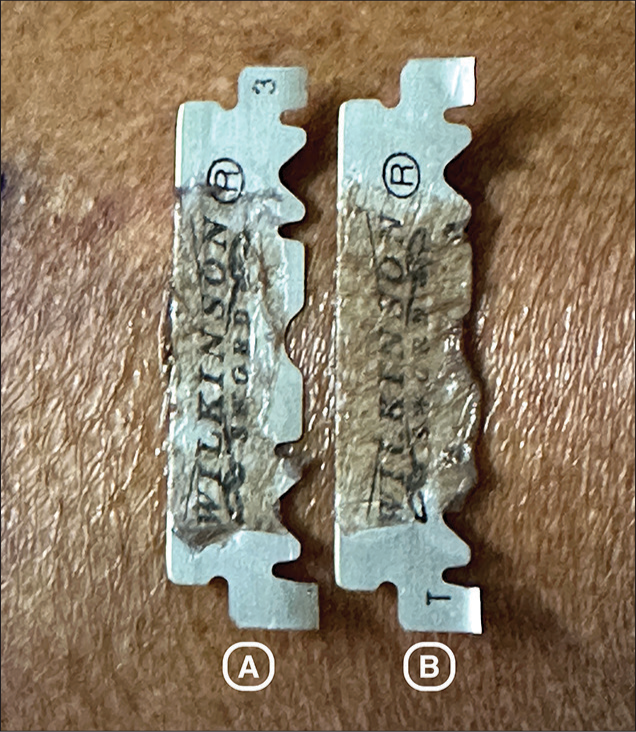Translate this page into:
Comparison between Silver’s knife and Razor blade technique in harvesting ultrathin epidermal sheets; which one is better?

*Corresponding author: Dr. Akshay Arun Vetal, Department of Dermatology, Lokmanya Tilak Municipal Medical College, Sion Hospital, Mumbai, Maharashtra, India. akkiii5858@gmail.com
-
Received: ,
Accepted: ,
How to cite this article: Dhurat RS, Vetal AA, Kowe P, Zatakia S. Comparison between Silver’s knife and Razor blade technique in harvesting ultrathin epidermal sheets; which one is better? CosmoDerma. 2024;4:144. doi: 10.25259/CSDM_166_2024
Dear Sir,
Surgical methods have been proposed as a therapeutic option for patients with stable vitiligo, based on the common principle of transplanting autologous melanocytes from a normal pigmented area to the affected depigmented skin. Harvesting ultra-thin epidermal sheets is considered a fundamental skill and a crucial step in tissue grafting, as well as cellular grafting surgeries in treating vitiligo.[1] Ultrathin grafts, without any dermal component, present cosmetically acceptable repigmentation at the recipient site and do not lead to significant scarring at the donor site.[2]
The knife, drum-type dermatome, and electric dermatome are the three basic instruments used for harvesting skin grafts. In daily practice, ultrathin epidermal sheets are mostly obtained with a Silver’s knife or a Razor blade. The Razor blade can be used by attaching it to artery forceps or with a guard.[3,4]
Attaching a Razor blade to artery forceps presents disadvantages such as irregular graft thickness, lack of precision, difficulty in obtaining long continuous grafts, and uneven edges. Mukhtar innovated the use of Gillette Guard Blade-1 for the collection of ultrathin epidermal sheets.[5] However, there is no comparative study between the two methods – Silver’s knife and Gillette Guard Blade-1. Silver’s knife features a Razor-blade holder carrying an ordinary three-holed blade with a guide to control the thickness of the skin cut, while Gillette Guard Blade-1 has a single-blade system with a safety guard.
We conducted a comparative study between Gillette Guard Blade-1 and Silver’s knife on 10 patients of different ages and sexes. Silver’s knife offered the thinnest graft compared to Gillette Guard Blade-1 in all subjects, also providing the advantage of long and uniform thickness grafts [Figure 1]. We have noticed that the Gillette Guard is best suited for bony areas and requires perpendicular pressure [Video 1], unlike the tangential force required with the Silver’s knife during graft harvesting [Video 2]. Therefore, ergonomically, the Silver’s knife provides enhanced precision and depth control [Video 2]. Adjusting the depth of grafts according to age, sex, and the donor site is crucial for obtaining ultrathin grafts. The cutting edge of Silver’s knife was kept minimum for the donor site with bony prominence and in elderly patients. This adjustment is constrained with the Gillette Guard Blade-1.

- The ultrathin epidermal sheet harvested using a Silvers knife on blade (A) is thinner than the one obtained with a Gillette Guard blade-1 on blade (B).
Silver’s knife is the instrument of choice for harvesting ultrathin grafts, offering enhanced precision with less procedural fatigue, showcasing its adaptability across various sites. Its ergonomic design, coupled with superior control, sets it apart from the Gillette Guard Blade-1, making it the preferred tool for surgeons, even for young trainees aiming for optimal outcomes in delicate procedures.
Ethical approval
Institutional Review Board approval is not required.
Declaration of patient consent
The authors certify that they have obtained all appropriate patient consent.
Conflicts of interest
There are no conflicts of interest.
Use of artificial intelligence (AI)-assisted technology for manuscript preparation
The authors confirm that there was no use of artificial intelligence (AI)-assisted technology for assisting in the writing or editing of the manuscript and no images were manipulated using AI.
Videos available online at
Financial support and sponsorship
Nil.
References
- Acquired pigmented disorders In: Griffiths C, Barker J, Bleiker T, Chalmer R, Creamer D, eds. Rooks textbook of dermatology Vol 88. (9th ed). Sussex: John Wiley and Sons; 2016. p. :34-40.
- [Google Scholar]
- Ultrathin split-thickness skin grafting followed by narrowband UVB therapy for stable vitiligo: An effective and cosmetically satisfying treatment option. Indian J Dermatol Venereol Leprol. 2012;78:159-64.
- [CrossRef] [PubMed] [Google Scholar]
- Evolution of instruments for harvest of the skin grafts. Indian J Plast Surg. 2013;46:28-35.
- [CrossRef] [PubMed] [Google Scholar]
- Razor blade: A simple instrument used in epidermal grafting for vitiligo. J Am Acad Dermatol. 2021;84:e17-8.
- [CrossRef] [PubMed] [Google Scholar]
- A novel use of gillette guard-1 blade for harvesting ultrathin Thiersch's graft. CosmoDerma. 2023;3:14.
- [CrossRef] [Google Scholar]





